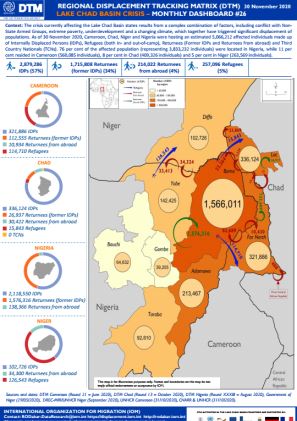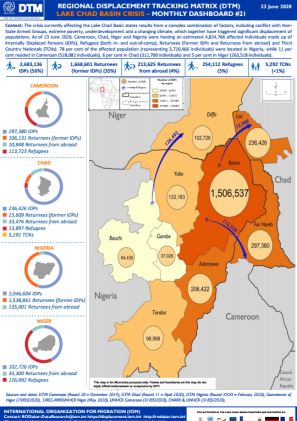-
Countries
-
Data and Analysis
-
Special Focus
-
Crisis Responses
Lake Chad Basin Crisis Monthly Dashboard
Title Standard
West and Central Africa — Lake Chad Basin Crisis Monthly Dashboard # (DATE)
Operation
Contact
Regional Office Dakar, RODakar-DataResearch@iom.int
Type
Component
Domain
Confidential
Region
The crisis currently affecting the Lake Chad Basin states results from a complex combination of factors, including conflict with Non-State Armed Groups, extreme poverty, underdevelopment and a changing climate, which together have triggered significant displacement of populations. As of 30 November 2020, Cameroon, Chad, Niger and Nigeria were hosting an estimated 5,066,212 affected individuals made up of Internally Displaced Persons (IDPs), Refugees (both in- and out-of-camp), Returnees (Former IDPs and Returnees from abroad) and Third Country Nationals (TCNs). 76 per cent of the affected population (representing 3,833,232 individuals) were located in Nigeria, while 11 per cent resided in Cameroon (560,085 individuals), 8 per cent in Chad (409,326 individuals) and 5 per cent in Niger (263,569 individuals).
The crisis currently affecting the Lake Chad Basin states results from a complex combination of factors, including conflict with Non-State Armed Groups, extreme poverty, underdevelopment and a changing climate, which together have triggered significant displacement of populations. As of 21 October 2020, Cameroon, Chad, Niger and Nigeria were hosting an estimated 5,034,347 affected individuals made up of Internally Displaced Persons (IDPs), Refugees (both in- and out-of-camp), Returnees (Former IDPs and Returnees from abroad) and Third Country Nationals (TCNs). 76 per cent of the affected population (representing 3,833,232 individuals) were located in Nigeria, while 11 per cent resided in Cameroon (559,871 individuals), 8 per cent in Chad (377,898 individuals) and 5 per cent in Niger (263,569 individuals).
The crisis currently affecting the Lake Chad Basin states results from a complex combination of factors, including conflict with Non-State Armed Groups, extreme poverty, underdevelopment and a changing climate, which together have triggered significant displacement of populations. As of 24 September 2020, Cameroon, Chad, Niger and Nigeria were hosting an estimated 5,034,347 affected individuals made up of Internally Displaced Persons (IDPs), Refugees (both in- and out-of-camp), Returnees (Former IDPs and Returnees from abroad) and Third Country Nationals (TCNs). 76 per cent of the affected population (representing 3,833,232 individuals) were located in Nigeria, while 11 per cent resided in Cameroon (559,699 individuals), 8 per cent in Chad (377,898 individuals) and 5 per cent in Niger (263,518 individuals).
The crisis currently affecting the Lake Chad Basin states results from a complex combination of factors, including conflict with Non-State Armed Groups, extreme poverty, underdevelopment and a changing climate, which together have triggered significant displacement of populations. As of 21 August 2020, Cameroon, Chad, Niger and Nigeria were hosting an estimated 4,994,349 affected individuals made up of Internally Displaced Persons (IDPs), Refugees (both in- and out-of-camp), Returnees (Former IDPs and Returnees from abroad) and Third Country Nationals (TCNs). 76 per cent of the affected population (representing 3,793,691 individuals) were located in Nigeria, while 11 per cent resided in Cameroon (559,443 individuals), 8 per cent in Chad (377,697 individuals) and 5 per cent in Niger (263,518 individuals).
The crisis currently affecting the Lake Chad Basin states results from a complex combination of factors, including conflict with Non-State Armed Groups, extreme poverty, underdevelopment and a changing climate, which together have triggered significant displacement of populations. As of 21 July 2020, Cameroon, Chad, Niger and Nigeria were hosting an estimated 4,929,195 affected individuals made up of Internally Displaced Persons (IDPs), Refugees (both in- and out-of-camp), Returnees (Former IDPs and Returnees from abroad) and Third Country Nationals (TCNs). 78 per cent of the affected population (representing 3,793,691 individuals) were located in Nigeria, while 11 per cent resided in Cameroon (559,236 individuals), 6 per cent in Chad (312,750 individuals) and 5 per cent in Niger (263,518 individuals).
The crisis currently affecting the Lake Chad Basin states results from a complex combination of factors, including conflict with Non-State Armed Groups, extreme poverty, underdevelopment and a changing climate, which together have triggered significant displacement of populations. As of 23 June 2020, Cameroon, Chad, Niger and Nigeria were hosting an estimated 4,824,766 affected individuals made up of Internally Displaced Persons (IDPs), Refugees (both in- and out-of-camp), Returnees (Former IDPs and Returnees from abroad) and Third Country Nationals (TCNs). 78 per cent of the affected population (representing 3,720,466 individuals) were located in Nigeria, while 11 per cent resided in Cameroon (528,082 individuals), 6 per cent in Chad (312,700 individuals) and 5 per cent in Niger (263,518 individuals).
The crisis currently affecting the Lake Chad Basin states results from a complex combination of factors, including conflict with Non-State Armed Groups, extreme poverty, underdevelopment and a changing climate, which together have triggered significant displacement of populations. As of 20 May 2020, Cameroon, Chad, Niger and Nigeria were hosting an estimated 4,822,507 affected individuals made up of Internally Displaced Persons (IDPs), Refugees (both in- and out-of-camp), Returnees (Former IDPs and Returnees from abroad) and Third Country Nationals (TCNs). 78 per cent of the affected population (representing 3,720,466 individuals) were located in Nigeria, while 11 per cent resided in Cameroon (527,779 individuals), 6 per cent in Chad (312,703 individuals) and 5 per cent in Niger (261,559 individuals).
The crisis currently affecting the Lake Chad Basin states results from a complex combination of factors, including conflict with Non-State Armed Groups, extreme poverty, underdevelopment and a changing climate, which together have triggered significant displacement of populations. As of 20 April 2020, Cameroon, Chad, Niger and Nigeria were hosting an estimated 4,794,990 affected individuals made up of Internally Displaced Persons (IDPs), Refugees (both in- and out-of-camp), Returnees (Former IDPs and Returnees from abroad) and Third Country Nationals (TCNs). 78 per cent of the affected population (representing 3,720,466 individuals) were located in Nigeria, while 11 per cent resided in Cameroon (526,587 individuals), 6 per cent in Chad (286,378 individuals) and 5 per cent in Niger (261,559 individuals).
The crisis currently affecting the Lake Chad Basin states results from a complex combination of factors, including conflict with Non-State Armed Groups, extreme poverty, underdevelopment and a changing climate, which together have triggered significant displacement of populations. As of 24 February 2020, Cameroon, Chad, Niger and Nigeria were hosting an estimated 4,670,984 affected individuals made up of Internally Displaced Persons (IDPs), Refugees (both in- and out-of-camp), Returnees (Former IDPs and Returnees from abroad) and Third Country Nationals (TCNs). 78 per cent of the affected population (representing 3,650,768 individuals) were located in Nigeria, while 11 per cent resided in Cameroon (524,116 individuals), 6 per cent in Niger (261,631 individuals) and 5 per cent in Chad (234,742 individuals).
The crisis currently affecting the Lake Chad Basin states results from a complex combination of factors, including conflict with Non-State Armed Groups, extreme poverty, underdevelopment and a changing climate, which together have triggered significant displacement of populations. As of 24 February 2020, Cameroon, Chad, Niger and Nigeria were hosting an estimated 4,668,408 affected individuals made up of Internally Displaced Persons (IDPs), Refugees (both in- and out-of-camp), Returnees (Former IDPs and Returnees from abroad) and Third Country Nationals (TCNs). 78 per cent of the affected population (representing 3,650,768 individuals) were located in Nigeria, while 11 per cent resided in Cameroon (524,116 individuals), 6 per cent in Niger (261,631 individuals) and 5 per cent in Chad (234,742 individuals).
Pagination
- Previous page
- Page 4
- Next page










